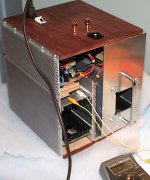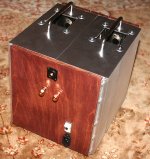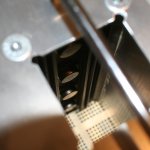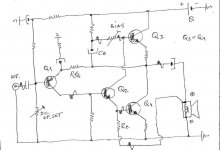Beautiful looking amp Bigun, great chassis design.
I like your speaker even more - looks DIY but to a very high standard. Must be huge!
I like your speaker even more - looks DIY but to a very high standard. Must be huge!
Member
Joined 2009
Paid Member
CFP VAS option
Thanks Christian.
I did a bit more listening. Finally I can know what is the JLH69 sound!
It has a nice sound, a bit laid back, not as 'accurate' as my Recent class AB amps. This promted me to consider a bit more exploratory work.
This evening I modified the amp by installing a Sziklai pair in place of TR3, the phase splitter/VAS. I used a 1k collector load for the master device across which the slave device derives its control voltage. The higher Hfe of this pair required some asjustment of the input device bias to keep the output at the mid point of the power rails.
I installed a 33p np0 cap across the b-c of the master device to ensure similar phase margin to the version I had before. Simulations say this will provide a similar UGF but with a good bump in OLG and a corresponding decrease in harmonic distortion, especially 3rd order and above.
A 1kHz square wave produced a clean output waveform without ringing.
Sound: I was not happy with this change. The magic seemed to be gone and the sound became a bit sterile. It was a cleaner sound, but bass was not as deep even if still well defined. The mids were 'flat' and overall I felt some irritation although I would not describe it as harsh. I would be happy with a cleaner sound but not an irritating sound. Interesting that my TGM2 gave me a similar feeling, it was an experiment with using a CFP LTP input stage compared with a regular LTP.
I will sleep on it, but chnaces are that I'll remove the CFP and go back to a single device for TR3.
Thanks Christian.
I did a bit more listening. Finally I can know what is the JLH69 sound!
It has a nice sound, a bit laid back, not as 'accurate' as my Recent class AB amps. This promted me to consider a bit more exploratory work.
This evening I modified the amp by installing a Sziklai pair in place of TR3, the phase splitter/VAS. I used a 1k collector load for the master device across which the slave device derives its control voltage. The higher Hfe of this pair required some asjustment of the input device bias to keep the output at the mid point of the power rails.
I installed a 33p np0 cap across the b-c of the master device to ensure similar phase margin to the version I had before. Simulations say this will provide a similar UGF but with a good bump in OLG and a corresponding decrease in harmonic distortion, especially 3rd order and above.
A 1kHz square wave produced a clean output waveform without ringing.
Sound: I was not happy with this change. The magic seemed to be gone and the sound became a bit sterile. It was a cleaner sound, but bass was not as deep even if still well defined. The mids were 'flat' and overall I felt some irritation although I would not describe it as harsh. I would be happy with a cleaner sound but not an irritating sound. Interesting that my TGM2 gave me a similar feeling, it was an experiment with using a CFP LTP input stage compared with a regular LTP.
I will sleep on it, but chnaces are that I'll remove the CFP and go back to a single device for TR3.
Last edited:
Member
Joined 2009
Paid Member
The beauty is back!
I ripped out the CFP VAS and put back the single non transistor. The readjusted the dc-offset to half the rail voltage.
The sound is back ! - I don't think I feel any more temptation to mess with it. Now it's time to sit back and enjoy 😎
This version of the JLH69 is now highly recommended!
I ripped out the CFP VAS and put back the single non transistor. The readjusted the dc-offset to half the rail voltage.
The sound is back ! - I don't think I feel any more temptation to mess with it. Now it's time to sit back and enjoy 😎
This version of the JLH69 is now highly recommended!
Attachments
Last edited:
Member
Joined 2009
Paid Member
Gareth, great project. I like the compartment design - vertical, with open "windows" at the top! 😎 Better airflow for sure.
CFP VAS observation is interesting...
Reminded me a BMW Convertible commercial, I came across some years ago - saying "Runs better without Windows" 😀
CFP VAS observation is interesting...
Reminded me a BMW Convertible commercial, I came across some years ago - saying "Runs better without Windows" 😀
Bigun you made great Amp , I like it !
-------------------------------------------------------------------------------------
BTW , what do you think about this small modification of original JLH 1969 circuit where phase splitter Q2- Re is disconnected from ground line and now connected to + terminal of load(speaker) ? , introducing some percent of local feedback to Q2 & Q4 , this small modification is based on J.Futterman original OTL concept .
Best Regards !
-------------------------------------------------------------------------------------
BTW , what do you think about this small modification of original JLH 1969 circuit where phase splitter Q2- Re is disconnected from ground line and now connected to + terminal of load(speaker) ? , introducing some percent of local feedback to Q2 & Q4 , this small modification is based on J.Futterman original OTL concept .
Best Regards !
Attachments
Member
Joined 2009
Paid Member
Looks interesting Banat, maybe try running it in Spice to see how it behaves - even if it doesn't work it might give some further insight so you can explore further.
The idea of a cooling chimney always made sense to me but whether it's worth the time to make one is another question!
Gareth, great project. I like the compartment design -
The idea of a cooling chimney always made sense to me but whether it's worth the time to make one is another question!
Last edited:
Member
Joined 2009
Paid Member
I just realized, this being the last single digit "TGM9", it marks the end of the TGM series. I'm now pretty much done starting new designs or new threads in the Solid State Forum.
Member
Joined 2009
Paid Member
Attached - final as-built schematic.
I've been listening to the amplifier and enjoying it. And in looking for a better way to describe the sound I discovered the following quote by Rudy, that says it very well:
I've been listening to the amplifier and enjoying it. And in looking for a better way to describe the sound I discovered the following quote by Rudy, that says it very well:
...The JLH has a unique smooth and 'flowing' or 'natural' sound, I think it is very special indeed. There are a few buts:
* I needed a 0.25 Ohm/5Watt resistor in the line between the upper 3055 and the positive side of the power supply. This takes away some hardening of the sound. We can not explain why this should make any diffence at all.
* I tweaked the circuit at great length (about 3 years of experimenting): resistors brands, transformers, types of 3055, caps etc etc. So I am pretty assured, after comparing it to several JLH's of friends, that the sound is okay.
* I miss some speed and clarity in the sound at times, it can sound a tad 'thick' and 'slow'.
* The Hiraga sounds more modern and open in comparison, but hasn't the beautiful midrange (vocals, piano) and flowing nature of the JLH.
...Rudy http://www.diyaudio.com/forums/solid-state/5270-simplest-amplifier-possible-bjts.html#post52505
Attachments
Member
Joined 2009
Paid Member
The 2N3055 is the pick up truck of power transistors, they are built rugged and you can throw them in to anything. But they were not meant for the high end. I happened across some heatsinks with a bunch of them riveted in place and took up the challenge of putting them to work. I learned along the way that the PSRR of the JLH is not great but can be readily improved in ways I hadn’t seen others use and that’s the main innovation in my version. The CFP VAS did not enthuse me.
Were I wanting to build another JLH69 I would take a different path with fewer output devices and they would not be these old one’s either.
I have purchased a Chinese made stereo amp which is the JLH69 circuit tipped upside down to use p-type outputs. They are LatFET’s, at least claimed as such. It sounds good, I sense that it retains some of the polite sound of my own JLH. Works just fine with a single pair of outputs. I bought it with the intention of transplanting my own design into it, saving me a whole lot of work by re-using the existing chassis, connectors, mechanical parts for the volume control extension rod, etc. And it looks nice roo. I’m not in a hurry as it sounds pretty good but I have wanted to build the JLH69 with the front end of my TGM8 amplifier.
Hope you are enjoying the hobby!
Were I wanting to build another JLH69 I would take a different path with fewer output devices and they would not be these old one’s either.
I have purchased a Chinese made stereo amp which is the JLH69 circuit tipped upside down to use p-type outputs. They are LatFET’s, at least claimed as such. It sounds good, I sense that it retains some of the polite sound of my own JLH. Works just fine with a single pair of outputs. I bought it with the intention of transplanting my own design into it, saving me a whole lot of work by re-using the existing chassis, connectors, mechanical parts for the volume control extension rod, etc. And it looks nice roo. I’m not in a hurry as it sounds pretty good but I have wanted to build the JLH69 with the front end of my TGM8 amplifier.
Hope you are enjoying the hobby!
- Home
- Amplifiers
- Solid State
- TGM9 - my version of the JLH '69 Class A amplifier





